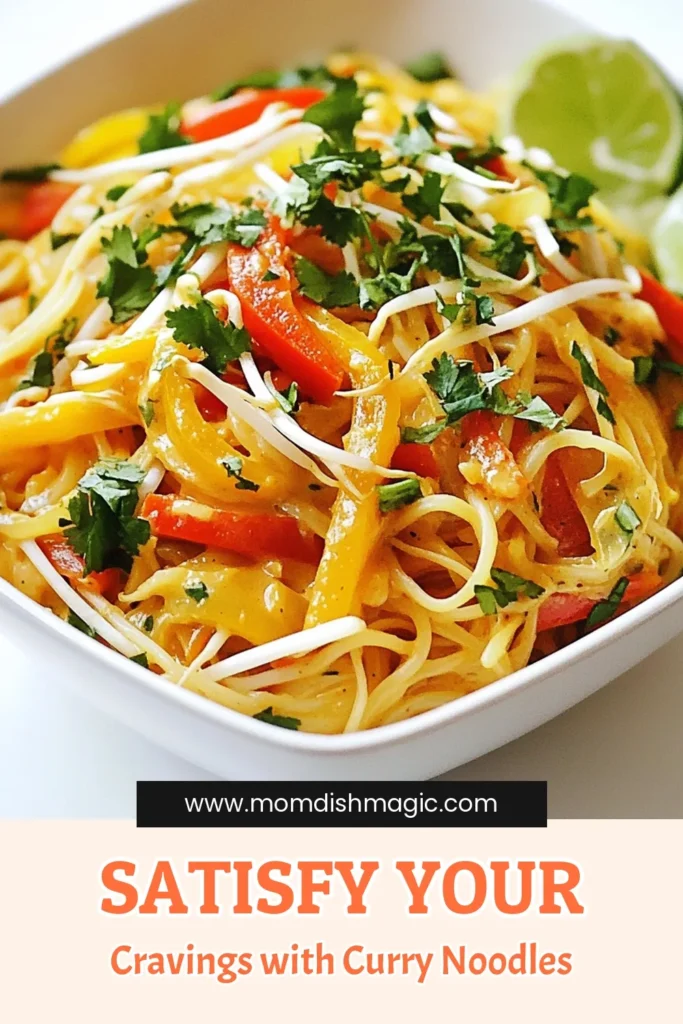WANT TO SAVE THIS RECIPE?
Are you ready to spice up your meal plan with vibrant Singapore Curry Noodles? I’m excited to share a straightforward recipe that bursts with flavor! With the perfect blend of spices and easy-to-follow steps, you’ll wow your family or guests in no time. Whether you’re a beginner or a seasoned cook, this dish is sure to satisfy your cravings and bring new excitement to your kitchen. Let’s dive into the delicious world of curry noodles!
Why I Love This Recipe
- Quick and Easy: This recipe can be made in just 30 minutes, making it perfect for a weeknight dinner.
- Flavorful and Spicy: The combination of curry powder and fresh chili gives these noodles a vibrant kick.
- Customizable: You can easily swap in your favorite vegetables or proteins to make it your own.
- Comforting and Satisfying: The creamy coconut milk creates a rich sauce that envelops the noodles beautifully.
Ingredients
Detailed Ingredient List
To make Singapore Curry Noodles, gather these tasty items:
– 200g rice noodles
– 2 tablespoons coconut oil
– 1 onion, thinly sliced
– 3 cloves garlic, minced
– 1 tablespoon ginger, minced
– 1 red chili, sliced (adjust to taste)
– 2 tablespoons yellow curry powder
– 1 can (400ml) coconut milk
– 1 tablespoon soy sauce
– 1 tablespoon fish sauce (or vegetarian option)
– 1 bell pepper, sliced
– 150g bean sprouts
– 2 spring onions, chopped
– Fresh cilantro, for garnish
– Lime wedges, for serving
These ingredients create a rich, creamy, and spicy dish. The rice noodles soak up the flavors very well.
Substitutions for Key Ingredients
You can swap some ingredients if needed:
– Rice noodles: You can use egg noodles or even whole wheat noodles.
– Coconut oil: Olive oil or vegetable oil works too.
– Fish sauce: You can skip it for a vegetarian option. Use more soy sauce instead.
– Cilantro: If you don’t like cilantro, try fresh parsley or green onions.
These swaps keep the dish tasty while meeting your needs.
Fresh vs. Dried Ingredients
Using fresh ingredients gives the best flavor. Fresh garlic, ginger, and vegetables add brightness to your dish.
– Fresh vs. dried garlic: Fresh garlic has a sharp taste. Dried garlic is milder and works in a pinch.
– Fresh ginger: It has a zing that dried ginger lacks. Use fresh for the best flavor.
– Fresh vegetables: Crisp bell peppers and bean sprouts add great texture. Dried vegetables won’t provide the same crunch.
I recommend using fresh ingredients whenever possible for the best results. They truly make a difference in your Singapore Curry Noodles!

Step-by-Step Instructions
How to Cook Rice Noodles Perfectly
To cook rice noodles, start by boiling water in a pot. Once the water boils, add the rice noodles. Cook them according to the package instructions. Usually, this takes about 4-6 minutes. Once cooked, drain and rinse the noodles under cold water. This stops the cooking process and keeps the noodles firm. Set them aside for later.
Sautéing Aromatics for Maximum Flavor
Next, heat 2 tablespoons of coconut oil in a large wok or frying pan over medium heat. Add the sliced onion, minced garlic, minced ginger, and sliced red chili. Sauté these for 3-5 minutes. You want the onions to become soft and see-through. This step brings out all the great flavors in the dish.
Preparing the Curry Sauce and Combining Ingredients
Now it’s time to add the spices. Sprinkle in 2 tablespoons of yellow curry powder. Stir this mixture for about 1 minute. This toasts the spices and wakes up their flavors. Then, pour in 400ml of coconut milk. Stir well to mix the coconut milk with the sautéed aromatics.
Next, add 1 tablespoon of soy sauce and 1 tablespoon of fish sauce. Let this simmer for 5-7 minutes. This thickens the sauce and blends the flavors. After that, toss in the sliced bell pepper. Cook for another 3 minutes until they soften.
Finally, add the cooked rice noodles to the wok. Gently toss everything together until the noodles are well-coated. Add 150g of bean sprouts and mix for another minute just to warm them through. Remove from heat and stir in chopped spring onions for a fresh touch. Enjoy your flavorful Singapore curry noodles!
Tips & Tricks
How to Achieve the Best Flavor
To get the best flavor, focus on fresh ingredients. Use fresh garlic and ginger for a strong taste. Sauté them with coconut oil until they smell great. This step builds a strong base for your dish. Also, use quality curry powder. Not all curry powders are the same. Find one that you like, as it greatly affects the taste. Lastly, don’t rush the simmering time. Letting the sauce thicken allows the flavors to meld.
Common Mistakes to Avoid
One common mistake is overcooking the noodles. Follow the package instructions and rinse them afterward. This keeps them from sticking together. Another mistake is skipping the toasting step for the curry powder. Failing to toast it can lead to a bland dish. Lastly, don’t forget the lime. Adding lime juice before serving brightens the entire dish.
Adjusting Spice Levels to Taste
To adjust spice levels, start with less chili. You can always add more later. If you want a milder dish, remove the seeds from the chili. For more heat, add sliced chili at the end. You can also add a pinch of chili flakes while cooking. This allows you to customize the spice to your liking. Remember, it’s easier to add than to take away!
Pro Tips
- Adjust Spice Level: If you prefer milder flavors, reduce the amount of red chili or remove the seeds before adding them to the dish.
- Vegetarian Option: For a vegetarian version, substitute fish sauce with additional soy sauce or a vegetarian fish sauce alternative.
- Perfectly Cooked Noodles: Make sure not to overcook the rice noodles; they should be al dente as they will continue to cook slightly in the hot curry sauce.
- Garnish for Freshness: Always garnish with fresh cilantro and lime wedges just before serving for an added burst of flavor and freshness.

Variations
Vegetarian and Vegan Options
You can easily make Singapore curry noodles vegetarian or vegan. Simply swap the fish sauce for more soy sauce or use a plant-based alternative. For a vegan touch, ensure you use coconut milk without additives. You can also add extra vegetables like mushrooms, zucchini, or carrots to boost nutrition and flavor.
Ingredient Swaps for Different Dietary Needs
If you have dietary needs, many ingredients can be swapped. Use gluten-free noodles instead of rice noodles for a gluten-free version. For a lower-carb option, try spiralized zucchini or shirataki noodles. If you want extra protein, consider adding tofu or chickpeas. These swaps keep the dish tasty while meeting your needs.
Regional Variations of Singapore Curry Noodles
Singapore curry noodles have many regional twists. In some areas, people add seafood like shrimp or fish. Others may include different spices or herbs, changing the flavor. You might find versions that use yellow curry paste instead of powder for a bolder taste. Each region’s variation shows the dish’s flexibility and global appeal.
Storage Info
How to Store Leftovers Properly
To keep your Singapore curry noodles fresh, store them in an airtight container. Let the dish cool down to room temperature first. Then, place it in the fridge. Proper storage keeps the flavors intact and makes it safe to eat later. Enjoy leftovers within three days for the best taste.
Reheating Tips for Best Results
When reheating, use a pan or skillet for even heating. Add a splash of water or coconut milk to prevent drying out. Heat on medium-low, stirring gently until warmed through. You can also use the microwave. Heat in short bursts, stirring in between until hot. This keeps the texture nice and creamy.
Freezing Instructions for Meal Prep
For meal prep, freeze Singapore curry noodles in single-serving containers. Make sure the dish cools completely before freezing. Use freezer-safe containers to avoid freezer burn. They can last up to two months in the freezer. To reheat, thaw in the fridge overnight and follow the reheating tips above. Enjoy your meal anytime!
FAQs
What is the origin of Singapore Curry Noodles?
Singapore Curry Noodles come from Singapore, a melting pot of cultures. This dish mixes flavors from China, India, and Malaysia. It showcases the use of curry spices and coconut milk. You will find this dish in hawker centers and restaurants. Each cook adds their twist, making it unique.
Can I use a different type of noodle?
Yes, you can switch the rice noodles for other types. Egg noodles or udon noodles work well too. Just be sure to adjust the cooking time. Each noodle type brings a different texture. Experiment to find what you enjoy most!
How do I make it spicier?
To make it spicier, add more red chili slices. You can also add chili paste or chili flakes. These will enhance the heat without changing the dish’s taste. Start with a little and taste as you go. You control the spice level!
This article showed you how to make Singapore Curry Noodles. We covered key ingredients, cooking steps, and smart tips to avoid mistakes. You also learned about variations and how to store your dish.
Now, you can create a delicious meal that fits your taste and dietary needs. Experiment with the ingredients and enjoy every bite. Happy cookin
Singapore Curry Noodles
A flavorful dish featuring rice noodles in a rich coconut curry sauce with fresh vegetables.
Prep Time 15 minutes mins
Cook Time 15 minutes mins
Total Time 30 minutes mins
Course Main Course
Cuisine Singaporean
- 200 g rice noodles
- 2 tablespoons coconut oil
- 1 unit onion, thinly sliced
- 3 cloves garlic, minced
- 1 tablespoon ginger, minced
- 1 unit red chili, sliced
- 2 tablespoons yellow curry powder
- 1 can (400ml) coconut milk
- 1 tablespoon soy sauce
- 1 tablespoon fish sauce
- 1 unit bell pepper, sliced
- 150 g bean sprouts
- 2 unit spring onions, chopped
- 1 unit fresh cilantro, for garnish
- 1 unit lime wedges, for serving
Begin by cooking the rice noodles according to package instructions. Once cooked, rinse under cold water to stop the cooking process and set aside.
In a large wok or frying pan, heat the coconut oil over medium heat. Add the sliced onion, garlic, ginger, and red chili. Sauté for about 3-5 minutes until the onions become translucent and fragrant.
Sprinkle the yellow curry powder into the wok, stirring for about 1 minute to toast the spices and release their flavors.
Pour the coconut milk into the pan, stirring well to combine with the sautéed aromatics and spices.
Add the soy sauce and fish sauce (if using) to the coconut milk mixture. Allow it to simmer for about 5-7 minutes to thicken slightly.
Stir in the sliced bell pepper and cook for an additional 3 minutes until they start to soften.
Add the cooked rice noodles to the wok, gently tossing them with the curry sauce until well coated and heated through. Add bean sprouts and toss for another minute just to warm them.
Remove from heat and stir in the chopped spring onions. Serve the noodles hot, garnished with fresh cilantro and lime wedges on the side.
Adjust the chili to taste for spiciness.
Keyword curry, noodles, vegetarian
WANT TO SAVE THIS RECIPE?





